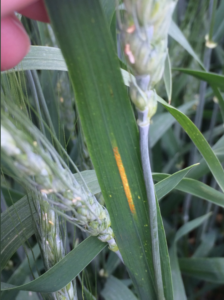Some re-planting has occurred in areas that received excessive moisture. Conversely, there have been reports of poor stands where seed wasn’t planted into moisture, particularly in Huron and Bruce Counties. The number of plant stand issues so far has been low compared to most years.
Forages
First-cut alfalfa is in full swing, with most dairy hay finished. Yields and quality have been good to date. Alfalfa weevil has been found in many areas. Scouting for feeding on regrowth after first-cut is important as weevils are entering the most damaging stages of third and fourth instars during the early stages of crop regrowth. Control is warranted if there are two or more active larvae per crown, or 4–8 larvae per 30 cm by 30 cm (1 ft2).
Winter wheat
The winter wheat crop is progressing well. Fusarium Head Blight fungicides have started to go on in the southwest portion of the province. However, due to the crop progressing quickly and the ideal window for a T3 fungicide passing, a number of acres in the southwest did not receive a T3 fungicide. As the crop progresses eastward growers are reminded to scout their fields for proper fungicide timing. Stripe rust has been reported in Ontario on June 5th in the St. Mary’s area (Figure 1) on a susceptible variety.

fig.-Stripe rust found in St. Mary’s, Ontario June 5th. Photo credit: Nicole Bloetjes.
Stripe rust found in St. Mary’s, Ontario June 5th. Photo credit: Nicole Bloetjes.Specific variety ratings for stripe rust can be found in the Ontario Cereals Crops Committee Performance trial data at www.gocereals.ca. Growers who have not yet applied their T3 fungicide and have a susceptible variety should continue to scout their fields and wait for the proper T3 fungicide timing if possible. Early spring cereal fields are at first to second node. Cereal leaf beetle (CLB) continues to be found in a number of non-traditional areas including Essex and Niagara Counties. Continue to scout for CLB in winter wheat if crop is approaching heading. One CLB adult or larvae per stem warrants control after boot but prior to heading. It is also important to scout for CLB in spring cereals as the crops progress.
Canola
Canola is progressing well with most of the crop between the 3 and at the 5 leaf stage. Flea beetle is being reported in canola; however, flea beetles are less active in the cool weather. Remember that flea beetle must feed on the seedlings to be exposed to seed treatment insecticides. Foliar insecticide application is not warranted until at least 25% foliar feeding is observed, and once the crop is at the 4 leaf stage it can likely outgrow the feeding damage.
Swede midge emergence was reported last week in the areas of Shelburne and Elora, and emergence is likely occurring now in all canola growing regions. Swede midge pheromone traps should be in place now and checked every few days through to bolting. Information on swede midge can be found on FieldCropNews.com
Edible Beans
Planting is about 30% complete with the remaining acres expected to be planted later this week and into next week.
Source : fieldcropnews